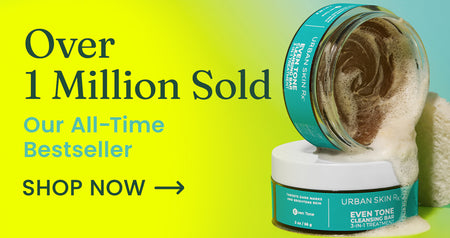How To Address Hyperpigmentation on Buttocks

We all know the old saying — hate to see you go, but love to watch you leave. But if you're struggling with hyperpigmentation on your rear, you may be worried that the parting view isn't quite up to snuff. As much as we love skin of every tone, texture and variation, things like hyperpigmentation can start to eat into your confidence!
So let's break down hyperpigmentation and talk about what it's doing on your derriere in the first place before we get into the best ways to address it so that you're left with smooth, even skin from head to toe.
What Is Hyperpigmentation?
Hyperpigmentation is the scientific name for dark spots and patches that can appear on your skin.
There are a few types of hyperpigmentation, and each type may call for a different treatment method. If you haven't dealt with hyperpigmentation before but are noticing it on your buttocks, it's worth a quick check-in with your doctor or dermatologist to make sure it's not connected to any medication or health condition.
That said, most of the time, hyperpigmentation is nothing to worry about — even if it can be frustrating.
One of the most common types of hyperpigmentation is post-inflammatory hyperpigmentation aka PIH. As the name implies, this happens after skin experiences irritation, trauma or inflammation. The trigger could be as simple as a breakout or as significant as a cut or wound. As your skin heals from whatever has damaged it, it overproduces melanin, resulting in a dark spot that forms in the location of the damage, like a scar.
There's also melasma, which is generally linked to hormones. It's frequently referred to as “the mask of pregnancy” because it often develops due to the hormonal changes one might experience during pregnancy. But hormonal shifts can also occur for other reasons, like due to medication or the phases of the menstrual cycle, so hormonal melasma isn't limited to pregnancy.
Sunspots are another type of hyperpigmentation. These dark spots crop up after an excess of sun exposure over time. We're not talking about one day when you forgot your sunscreen — it's more likely to see sunspots as you get older and have been exposed to potentially harmful UV rays for an extended period of time.
What Causes Hyperpigmentation on Your Buttocks?
Hyperpigmentation on your face is perhaps a more common concern — it's something you look at every day, which may not be true of your rear end. Although maybe it's true, we don't judge.
Really, there's no difference between the dark spots and marks you might struggle with on your face and those that appear on your body.
In fact, hyperpigmentation can happen easily on high-traffic areas like your buttocks. And no, we're not being cheeky! Your rear-end experiences a lot of friction throughout the day, from underwear, clothing and even everyday movements like sitting down. This friction can lead to irritation over time even if you don't feel it, resulting in the post-inflammatory hyperpigmentation we talked about above.
Additionally, the skin around your buttocks — as well as that around your armpits, elbows and knees — tends to have more melanocytes, which are the cells that produce melanin and give your skin its pigment. If you have a dark complexion, your skin is already rich in melanin, so people of color may be more prone to hyperpigmentation on the buttocks — and elsewhere overall.
Post-inflammatory hyperpigmentation can also be triggered by folliculitis. Folliculitis is inflammation or infection of a hair follicle — it's a fancy explanation for the pimples you sometimes get on your body that look like whiteheads. Instead of being a clogged pore, it's an issue with your follicle.
Folliculitis can be caused by shaving, friction and even tight clothing. If you wear tight leggings or shorts to the gym and scroll through your phone on the couch for an hour in your sweaty clothes, you're going to want to cut that out. It might be what's causing your folliculitis, which is, in turn, causing hyperpigmentation.
While knowing what's causing hyperpigmentation on your buttocks may be interesting, we know why you're really here — to figure out how to get rid of it.
We hate to disappoint! So let's talk about some of the best ways to address hyperpigmentation on your buttocks.
How Can You Address Hyperpigmentation?
When we say skincare, you probably think about your face — but the truth is, you should really be trying to look after your body with the same level of care, because while some of the skin on your body may be more durable than your face, not maintaining a proper routine can contribute to some of the issues that lead to hyperpigmentation.
Let's talk about the key steps to an excellent all-over skincare routine that can help you address butt hyperpigmentation. While it may be one or two more steps than you're used to, think of it as a great excuse for some extra self-care — plus, your future self will be thankful next time you're at a pool party and a friend wants to take a cheeky pic.
Exfoliating
As you probably know from your facial skincare routine, there are two types of exfoliating — chemical and physical. Our BrighterDays™ Dark Spot 8% AHA Polish acts as both a chemical and physical exfoliant, and it can be used on your buttocks as well as on your face!
This hyperpigmentation-busting polish harnesses the chemical exfoliating power of Alpha Hydroxy Acids like Glycolic Acid and Lactic Acid to help loosen the bonds between your skin cells, enabling older, uneven skin to be more easily shed. This can reduce the appearance of your dark spots over time and help keep your pores and follicles cleaned out to reduce body breakouts that might trigger uneven skin tone.
In addition to AHAs, our Polish uses powerful antioxidant Vitamin C to help neutralize free radical damage, so it's also useful if your dark spots are a result of sun damage. Papaya Extracts rounds out this formula, improving the look of rough texture and dull skin while contributing to a brighter, more even skin tone.
The other type of exfoliation is physical. This is when you use something mildly abrasive on your skin to gently slough away dead skin cells and other impurities, giving your skin the inspiration it needs to renew itself and resulting in more even skin over time.
For this, we like our Clear and Even Tone Body Cleansing Bar & Exfoliating Pouch, which leads us to…
Cleansing
The same bar that's in the exfoliating pouch, our Clear and Even Tone Body Cleansing Bar, is exactly what you need to take your shower from daily must-do to daily can't-wait-to-do. Not only is it the perfect little self-care moment, especially when paired with the exfoliating pouch we mentioned, but it leaves your skin feeling fresh, clean and renewed — without stripping moisture.
It's perfect for hyperpigmentation on your bum because it uses the powerful brightening agent Kojic Acid to help support balance in your skin.
In general, cleansing the skin on your body properly is important! Your drugstore body wash may smell great, but it's probably not doing the trick as far as keeping your skin clear and preventing folliculitis — so it could be contributing to your hyperpigmentation.
Treating
When it comes to your body skincare routine, this is where it gets a little extra — but trust us, it's worth it. Our Clear Skin Clarifying Back & Body Spray is the perfect low-maintenance addition to your routine. Instead of having to wrap your mind around slathering and rubbing in an additional product to your skin, all you need to do with this hyperpigmentation superstar is to spray it on your skin and let it air dry one to two times a day.
Our Body Spray uses Glycolic Acid to provide gentle chemical exfoliation and Willow Bark Extract and Salicylic Acid to penetrate into your pores and remove any impurities that may be affecting your skin. Niacinamide rounds out this spray with its unmatched ability to visibly improve fine lines, wrinkles, discoloration, texture and even redness.
Think of this like your serum step! It's where you want a product that works really hard for your specific skincare needs on your shelf, and this body spray has your back — literally.
Protecting
Before you step out for the day, the last step of your skincare routine should be SPF — and not just on your face. It's easy to overlook body sunscreen in the day-to-day, but especially if you're doing time poolside, you'll want to protect your rear from the sun's harmful rays, which can create or exacerbate dark spots over time.
To keep things simple, we've combined the perfect moisturizer with the perfect mineral SPF 30. Our SheerGlow™ Even Tone Daily Defense Mineral Moisturizer SPF 30 gives you total non-chemical coverage from the sun's harmful rays without leaving you looking like a ghost, no matter what your skin tone is.
It also includes pore-decongesting Safflower Seed Oil and Grapefruit Extract, which is antioxidant-rich and can help brighten the look of your complexion, even as you protect it from further damage.
How Do You Prevent Hyperpigmentation From Coming Back?
Everyone loves a sequel, but not when it comes to hyperpigmentation. Even if you manage to get rid of the stubborn hyperpigmentation on your buttocks now, you might be wondering what you can do to keep it away.
The first thing is not to stop using your skincare products as soon as things start to look brighter down there. It can be tempting to consider your routine a success and call it a day when your skin looks more even, but it's crucial to continue a consistent routine no matter what. By exfoliating regularly, cleansing properly and maintaining a treatment designed to target your concerns, you'll keep your skin clean, clear and prepared to fight off whatever nature throws its way next.
It's also worth noting that while skincare products can be effective in improving the look of hyperpigmentation, they're not going to fix it instantly. Depending on how deep your hyperpigmentation is, it can take weeks to months to see real results. Consistency is key!
There are some minor lifestyle changes you can make, too, to cut down on future instances of hyperpigmentation on your buttocks. For one, it's time to let workout leggings go.
Yes, they make your butt look great, but they're terrible for your follicles, and they don't let your skin breathe. If you must wear leggings or other tight clothing, make sure that as soon as you're done working out, you shower — or at least change into something clean and breathable. Sitting in sweaty, tight clothing is a recipe for disaster when it comes to hyperpigmentation.
It's also important to always apply sunscreen, even if you're looking to get a tan. It might take you a little longer to get that all-over summery glow you crave, but it's worth cutting back on. While sun spots on your buttocks most likely aren't cause for concern, if they change in appearance rapidly, continue to grow or come on suddenly, it's worth visiting your doctor or dermatologist to ensure everything is okay.
Lastly, if you get a razor anywhere near your buttocks, ensure you're treating everything with care. Razor bumps generally are folliculitis, which can result in hyperpigmentation later. So if you do shave, make sure you're exfoliating before, using shaving cream during and properly moisturizing after.
In Conclusion
Few things can get in the way of total confidence quite like knowing that your skin isn't as even as you want it to be. Especially during the summer, clothes get smaller and there are more occasions to get into your favorite bikini — and it can be hard to feel like you're at your best if you're trying to hide dark spots.
By adjusting your skincare routine and having some extra consideration when it comes to certain lifestyle factors, you can even the look of your skin and get that head-to-toe glow that will make you shed your swimsuit cover-up with total confidence.
Engagement Manager




